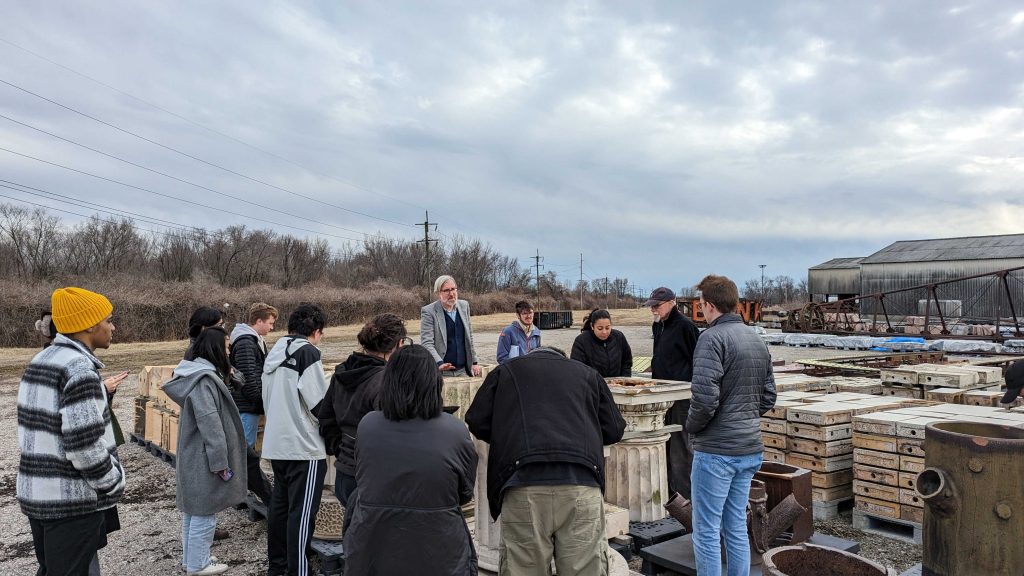Mission

The National Building Arts Center (NBAC) fosters understanding of America’s built environment—past and future—by promoting creative public engagement with its unparalleled collection of architectural artifacts and archives.
The major program areas of the NBAC follow:
Artifact Collections: The NBAC holds the largest collection of built environment artifacts in the United States, inclusive of a massive array of pieces of St. Louis collected since 1973, parts of the Anonymous Arts Recovery Society collection from New York City, and artifacts from Chicago, Philadelphia, and other US cities. The collections include several complete or near-complete building elevations. NBAC aims to be the leading lender of artifacts for exhibition and research on the historic built environment of the US.
Archive and Library: The NBAC maintains a large archive and library that offers an expansive body of knowledge around the US historic built environment, including architectural design, materials manufacturing and conservation, labor history, urban studies, geology, transportation, patenting and all aspects of building. The archive and library continues to support researchers ranging from authors working on book projects to university classes studying historic preservation.
Curating and Educating: The NBAC activates its collections through exhibitions crafted in partnership with other institutions, publications around building materials and the built environment, lectures focused on social and material histories of the built environment, collaborations with artists and others making creative work based on our collections and consultation to parties engaged in architectural conservation and salvage.
Vision
The National Building Arts Center (NBAC) wants to tell the full story of building culture.
We aim to lead a new discussion about the American built environment – once in which architectural history opens into a holistic understanding of material, craft, labor, design and sociopolitical context. The material culture of American architecture long has been defined through study of aesthetic innovation divorced from a wider understanding of how building technology depends upon invention, economic and political factors, and inherited knowledge.
We aim to revive traditions in material craft, not simply to conserve historic buildings, but also to revive these crafts in construction today. We aim to present the story of architecture’s allied arts, once indispensable to its achievements, but rarely taught in school or mentioned in academic texts today. The reduction of built heritage to lists of styles and designers has robbed us of a richness in understanding how the built environment came to be, how its contemporary conservation challenges can be solved and how we are responsible for its future. We want to widen, not narrow, what people see in the American built environment.
NBAC promotes the study of building culture instead of isolating its components into fragmented fields. In the long term, we hope to change the way in which Americans conceive of their building culture, including the idea that its history is somehow over and behind us. In order to identify, interpret and conserve the full scope of built heritage in America, we need stewards who want to connect what the evolution of design to advances in engineering, to connect the future of US cities to reclaiming sustainable traditions of material craft, and to connect the understanding of buildings to the human hands and minds that shaped every step of their construction.
Our work is informed by a preceding dream of a museum of American architecture originally proposed for the Jefferson National Expansion Memorial in the twentieth century. Today, we join the curatorial promise of that project with a contemporary dedication to facing the challenges of continued destruction of American urban built environment, the urgency of understanding the impact of climate change on built heritage and the need to create new educational paths for the next generation of builders, makers, architectural historians, historic preservationists and urban planners.
Past Plans for an Architecture and Allied Arts Museum at St. Louis
“A Museum of American Architecture” (Jefferson National Expansion Memorial 1936 plan for the Museum of American Architecture)
“The Museum of American Architecture: A Progress Report” (1941 update on the Museum of American Architecture)
“An Architectural Museum on the St. Louis Riverfront” (2018 article by Gateway Arch National Park Historian Bob Moore)